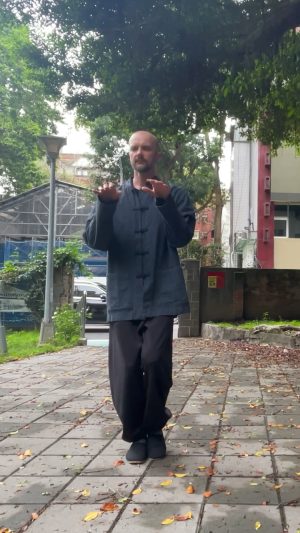Standing Tai Chi Forms
- Rise and sink
- Hold an energy ball
- Part the wild horse’s mane
- Ward off
- Single whip
- Rooster stands on one leg
- Whirl forearms
- Yin-yang arm preparation and palm strike
- (Bonus) Tai Chi backstep
Preparation moves
There are three preparation moves that show up in a lot of the forms that you need to be familiar with before you get started.
Set posture, and open your stance
- Stand with your feet together and your arms comfortably down and at your sides
- Heels should be touching
- The inside of your feet should be touching
- The inside of your knees should be gently touching
- Your weight is balanced on the balls of your feet
- Your pelvis is tilted up and in to create a straight posture with no stress on your lower back
- If you look at yourself sideways in a mirror, the top of your head should be directly above your pelvis – there should be no lean forward or backward
- Your core is engaged at about 10% tension
- Your shoulders are relaxed and settled away from your ears
- The top of your head is actively reaching toward the sky
- Allow 100% of your weight to shift to your right leg
- Lift the heel of your left foot, then your toe, and slowly move that foot to shoulder width.
- Let your toe touch down, then slowly put 50% of your weight back to each leg, and center your body weight in the middle, and sink into the posture
- Spread your fingers like they are on the outside of a basketball, not gripping the ball, but just resting on the outside.
Triple forward strike
- Set your pre-strike posture
- Arm should be raised to the side with a gently bent elbow
- Shoulder is relaxed
- Look at the moving arm, and bend the elbow so that fingertips are pointed directly at your forehead
- With one motion, push your fingertips straight forward
- When pushing your hand forward, the tip of your right thumb will follow a path directly in front of your solar plexus
- As the hand moves forward, fingertips begin to point upward so the knife edge of the hand is pointing forward, and then the knife edge twists so that the motion ends in a palm strike.
- This creates a triple-strike motion, moving fluidly from a fingertip strike, to a hand knife-edge strike, to a palm strike
- First the fingertips move directly toward the center point, then the thick part of the knife-edge, and then the tip of the thumb.
Yin Yang palms arm preparation (in progress)
1. Rise and Sink
The first part of the Standing Tai Chi forms is to ground yourself and raise and lower your arms.




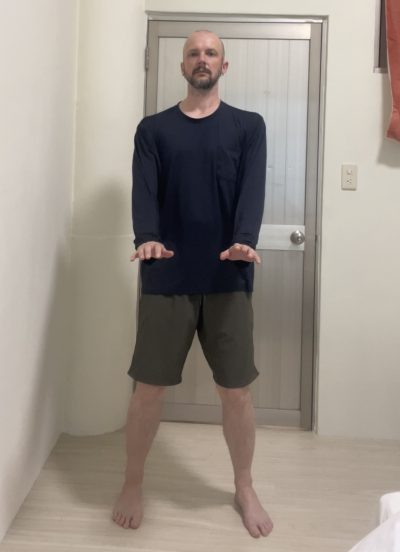
Level 1 – Video Script
- Stand with your feet shoulder-width apart (follow details above)
- With palms down, raise your hands to shoulder level
- Let your palms sink to your waist level, and let your knees bend slightly
- Breathing in while raising your arms, and breathing out while dropping them
Chinese (chat GPT version)
- 雙腳站立,與肩同寬。
- 掌心向下,雙手提升至肩膀高度
- 掌心下沉至腰間,膝蓋稍微彎曲
- 吸氣時舉起雙手,呼氣時雙手下放。
Level 2 – Details
- Set posture, and open stance (details above)
- Breathe in, and with space underneath your armpits and elbows slightly bent, raise your arms by using power and energy from your wrists and the center of your palms
- Stop and settle the motion when your relaxed hands rise to shoulder level
- Your arms should be level with the ground
- Breathe out, bend your knees into a comfortable posture, and let your arms drop by connecting your mind with your shoulders, then relaxing your elbows, and finally sinking your wrists. The motion should feel like you are gently pressing two large balls down into the water. The breath out ends when the ball is submerged.
- Breathe in and begin the upward motion again, focusing on channeling the Qi from the ground up through the balls of your feet and into your Dan Tien, then up your spine in the back, then down your chest, and down to your feet
2. Hold an energy ball and twist
Form 2 is to hold an energy ball. This will get your arms prepared for the next forms, Part the Wild Horse’s Mane and Ward Off. Both of these postures begin with the Hold an Energy Ball form.



Video Script
- Stand with your feet shoulder-width apart
- Put your hands around an invisible ball in front of your chest.
- Twist to the right and move your arms so the left hand is underneath and the right hand is on the top.
- Twist to the left and rotate the ball so your right hand is underneath and your left hand is on the top.
- Keep twisting back and forth, keeping palms facing each other
Chat-GPT version –
- 雙腳站立,與肩同寬。
- 胸前雙手環抱一顆隱形的球。
- 身體向右轉,移動雙臂,左手在下,右手在上。
- 身體向左轉,旋轉隱形球,右手在下,左手在上。
- 保持來回旋轉,雙掌保持相對。
Details (in progress)
- Set posture, and open stance
- Put your hands around an invisible ball in front of your chest.
- Turning from your waist, twist gently to your right to a 45-degree angle, and put 70% of your weight on your right leg
- Turn your left palm up while your left arm drops underneath the ball at waist level. Your right arm will rotate to chest level with the right palm down.
- Twist back toward the left and slowly move your hands so the left palm will be facing up and the right palm is now facing down. Shift your weight to follow the lower hand.
- Keep twisting back and forth, alternating the positions of your hands and your weight distribution, always keeping the energy ball between your palms.
3. part the wild horse's mane
Form 3 is “Part the Wild Horse’s Mane”. It’s one of the more interesting visual descriptions in Chinese. In English, it might be easier to thing “part the waves.” When your hands cross each other, they’re at a 45 degree and the way they cross is like you are separating two things, like separating two aspects of a wave in the ocean.

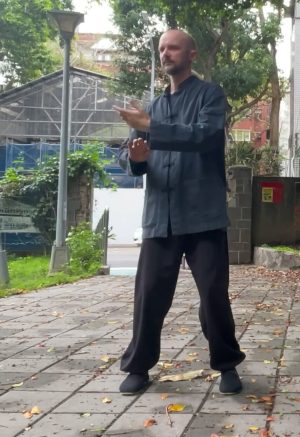



Part the wild horse’s mane
Video script
- Stand with your feet shoulder-width apart
- Hold an energy ball toward your right corner with your left hand on the bottom and right hand on the top
- Twist back to the center while raising your left hand directly in front of your chest, fingertips pointing upward, and letting your right hand fall to hip level
- Now twist to the left and hold the ball with your right hand underneath and your left hand on the top.
- Twist back to the center, while raising your right hand in front of your chest, fingertips pointing upward, and letting your left hand fall to hip level
- Repeat this motion back and forth
Chat GPT version –
- 站立时双脚与肩同宽。
- 以左手在下、右手在上的方式,向右前方托起一颗能量球。
- 转身回中央,同时提升左手至胸前直立,指尖向上,让右手降至臀部水平。
- 然后向左转身,换成右手在下、左手在上托球。
- 再次转身回中央,提升右手至胸前直立,指尖向上,左手降至臀部水平。
- 反复进行这一系列动作。
Details (in progress)
- Set posture, and open stance
- Twist gently to your right to a 45-degree angle, turning from your waist, while you put your hands around an invisible ball in front of your chest, with your right palm facing down and your left palm facing up
- While you twist back to center, raise your left hand, palm upward, so that your fingertips are pointing directly forward in front of your chest, keeping your elbow down and relaxed
- Your little finger will eventually be directly in front of your center line, and your fingertips will be just under your eye line
- Let your right hand naturally drop to your waist level, with your palm facing the ground and fingers pointed directly forward
- Make the invisible energy ball again, this time with your right hand on the bottom and left hand on the top
- Twist to the left, turning from your waist
- Twist back to center, raising your left hand, palm up, to point directly forward in front of your chest, while your right hand, palm down, drops to your waist level
- Repeat this motion back and forth
4. Ward off
Form 4 is called “ward off.” This motion usually isn’t done alone, but as part of a sequence called “Grasping the Sparrow’s Tail.” The ward off motion is very similar to “Part the Wild Horse’s Mane,” but the motion of the active arm is a little different. The arm stays parallel to the ground rather than coming up at a 45 degree angle, and the fingers are pointed sideways rather than up. To stay centered, when the ward off motion is complete, the energy focus point of the front palm is directly in front of the solar plexus, acting like a kind of shield.


Ward off (in progress)
Form 5 - single Whip
Form 5 is the “Single Whip.” It doesn’t show up in the Tai Chi 8-form, but it shows up consistently in the 24, 37, and 42 forms, and is a very good motion to be comfortable with. It is often combined with other very specific movements, so a good foundation is very important.

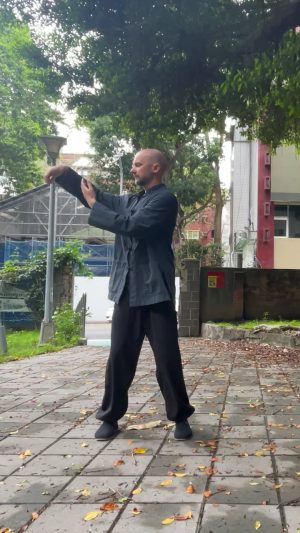


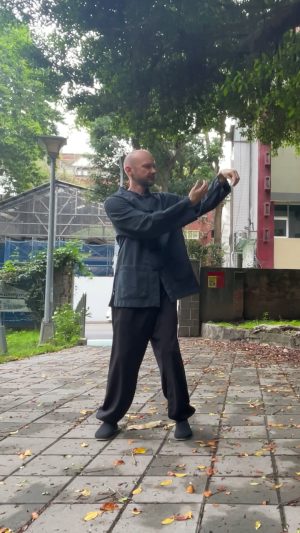
Single whip – in progress
6. Rooster stands on one leg
Form 6 is “Rooster Stands on One Leg.” This is the first form where you have to learn to keep your balance on one leg. The motion is very simple, but the mechanics to make it feel grounded take lots of practice, and the details require quite some concentration.
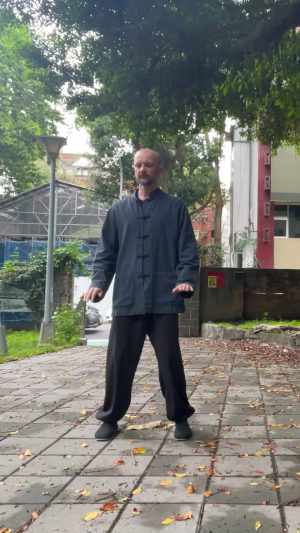


Rooster stands on one leg (in progress)
7. Whirl forearms
Form 7 – “Whirl Forearms” starts getting much more complicated when it comes to moving parts. Your gaze follows your active hand. You have multiple individual intentions with your two arms. The direction of your palms is very specific. Practice, practice, practice!
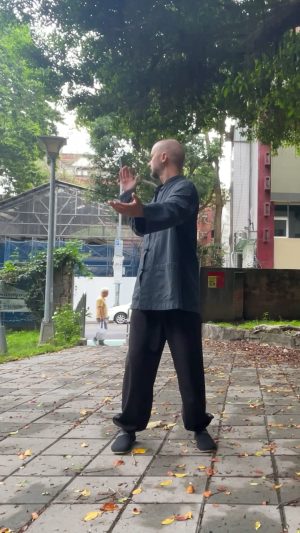



Whirl Forearms (in progress)
8. Brush Knee and Twist
Form 8 is “Brush Knee and Twist”, but it’s not exactly an accurate name. Brush Knee and Twist requires a step forward, but with Standing Tai Chi, we’re keeping things simple. So, the arm motions are technically the same, but the overall motion is quite a bit different. Practice standing first, and when the step comes, it will be nice and natural.



Whirl Forearms (in progress)
9. Tai Chi backstep
This is no longer part of Standing Tai Chi, but rather a short introduction into what’s coming next. There are two types of Tai Chi step. The first one is the backstep, which is what is used in the 8-form. The other is the Tai Chi walk, which is used in the further forms. They share some of the same principles but have very different motions. The Tai Chi backstep and walk are always combined with arm motions when in real utilization.

